Skydio 2 Drone Answers All My Autopilot Requests: Cheaper, Smaller, Smarter
I love drones but I'm a terrible pilot, and that's why Skydio's self-flying technology is so appealing – particularly when the new Skydio 2 makes it so much more affordable. Back when the Skydio R1 launched last year, it was an expensive taste of what AI-powered autopilot could do. Now, Skydio 2 aims to fly that right into the midst of the mainstream drone segment.
Even in a crowded quadcopter market, the original Skydio R1 was an astonishing outlier. Delivering obstacle detection and object tracking performance leagues ahead of anything rivals could manage, it was the closest we'd seen to the promise of a true virtual drone pilot. Multiple updates, adding new flying styles, camera tricks, and expanding where the R1 could operate, doubled-down on its promise.
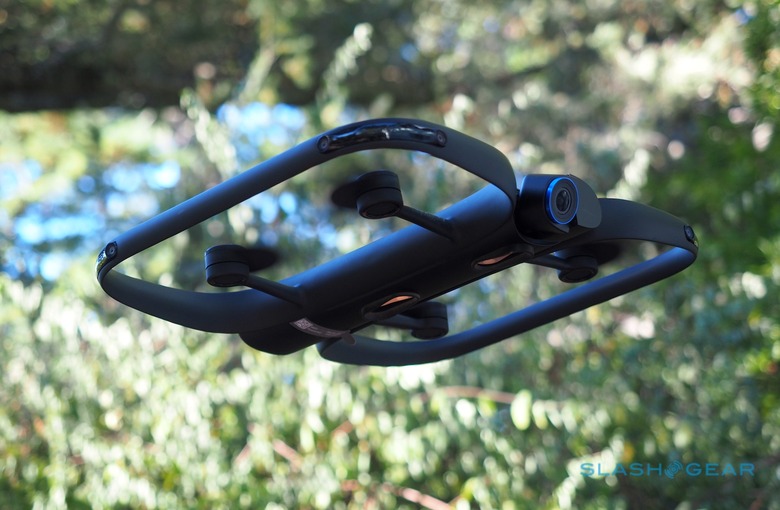
That's not to say it was perfect, mind. While the tracking and self-flying technologies were great, the drone itself was conspicuously large. Though it could be relied upon to keep itself safe from damage in the air, the fixed body and overall size put it at risk if you managed to squeeze it into a carry-on bag. Meanwhile though the autopilot features were easy to operate – even from an Apple Watch – manual flying was tricky through the phone-only interface. Oh, and it cost a whopping $1,999.
Enter Skydio 2
If the Skydio R1 was the test-bed, then Skydio 2 is the technology making a play for the mainstream. Half the size of the old model – and, at $999, half the price too – its bundled compact carry case has roughly the same footprint as that of a 13-inch laptop. Gone are the fixed blade protectors, something Skydio could do by completely reworking its camera system.
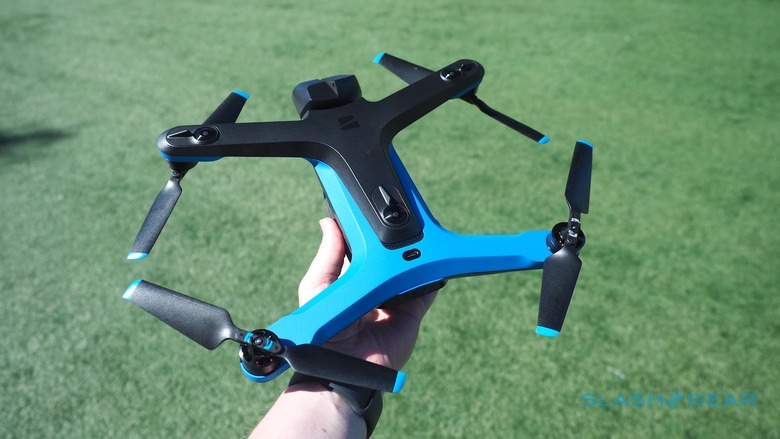
Now there are six 4K, full-color cameras, each with a 200-degree fisheye lens. Three are on the top, the remaining three underneath. Although there may be fewer than before, they add up to a huge bump in resolution: Skydio 2's algorithms now have 46-megapixels of data from all around the drone to play with, compared to the 3-megapixels on the R1.
Those algorithms run on an NVIDIA Tegra X2 with twice the processing power of before. Skydio's neural network can figure out contextually what it's looking at, then combine that with texture information to understand how far away an object might be. It's clever enough to know the geometry of things like power lines, and extrapolate them even if the cameras can't see them. Even in challenging environments like indoors, faced with featureless white walls, Skydio 2 can plot a safe course.
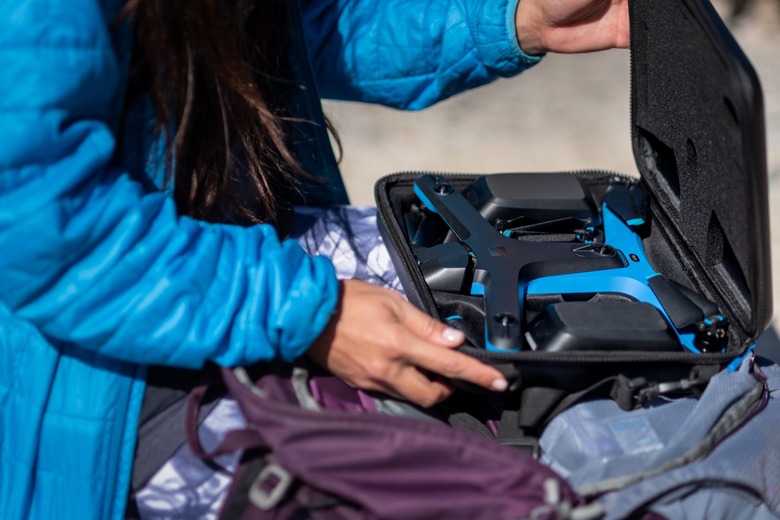
Combined with that is a motion planning system, which takes into account the drone's capabilities and environmental factors. It knows how much it can push the motors, for example, and how a gust of wind might affect aerodynamics – and, crucially, pre-empt what movements would best counter those factors. Skydio pointed a leaf-blower at it, at full whack, and it hardly shuddered. Indeed, the company is so confident in its autopilot tech, it's promising to repair or replace a crashed Skydio 2 if pilots had been following the Safe Flight guidance when the incident happened.
Faster, better quality, and easier to control
Alongside the six new autopilot cameras, there's a new primary camera which is now in-house designed. It uses a Sony image sensor with Qualcomm ISP, and can deliver up to 4K HDR footage at 60fps. There are also 1080p 120fps modes, along with support for 24/48fps.
Footage should be easier to extract, too, thanks to a microSD card slot. Charging, too, is more straightforward: you can plug in a USB-C charger right into the drone, or detach the batteries and use a separate adapter. Top speed has risen from 25 mph to 36 mph, but Skydio says this second-generation model should still deliver up to 23 minutes of flight time.
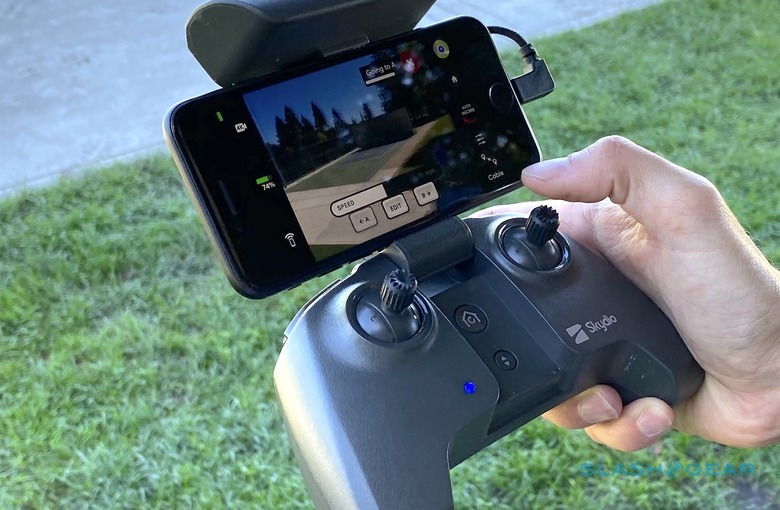
Out of the box, you control Skydio 2 with your smartphone, from up to about 650 feet away. However for this new drone, the company has two new options. The first is the Skydio 2 Controller, a $149 control pad with joysticks and buttons – it's actually Parrot's Anafi controller, which Skydio reprograms to work with its drone from more than 2.1 miles (3.5 km) away – that holds your phone but offers more traditional controls for those who want to operate manually.
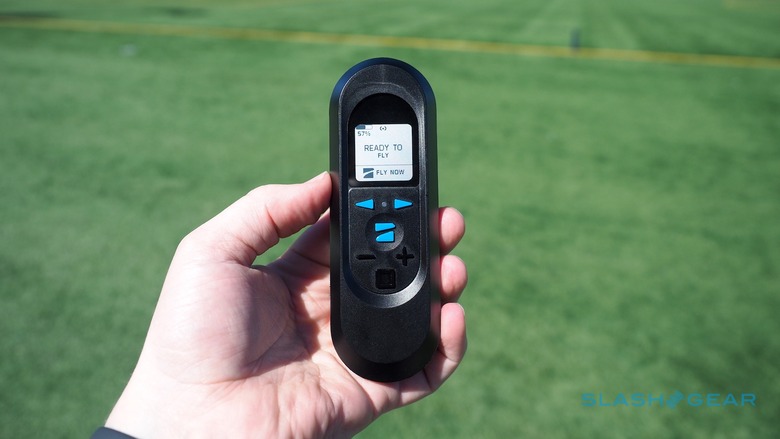
The other option is the Skydio Beacon. Also priced at $149, it looks like a digital voice recorder, with a cluster of buttons and a small screen. Beacon pairs with your phone, but allows Skydio 2 to use both visual and GPS tracking: that way, even if you're out of sight of the drone, it can still follow you. It too boosts range, extending it up to just shy of a mile (1.5 km).
Skydio 2 in action
I'd be lying if I said I wasn't hoping to fly Skydio 2 into a tree. Spoiler: I couldn't get the first-generation drone to crash, and neither could I get this new version to either. Skydio's person tracking abilities remain astonishingly good, but it's how they combine with the object avoidance that is really miraculous.
I am, typically, a poor drone pilot. Getting the basics is easy; getting to the point where you can make smooth, sweeping movements, while keeping a target in frame, and without inadvertently smashing into something in the process, is a whole lot tougher. Skydio 2's strength is that it bypasses most of the headaches in that process and allows you to focus on the creative stuff.
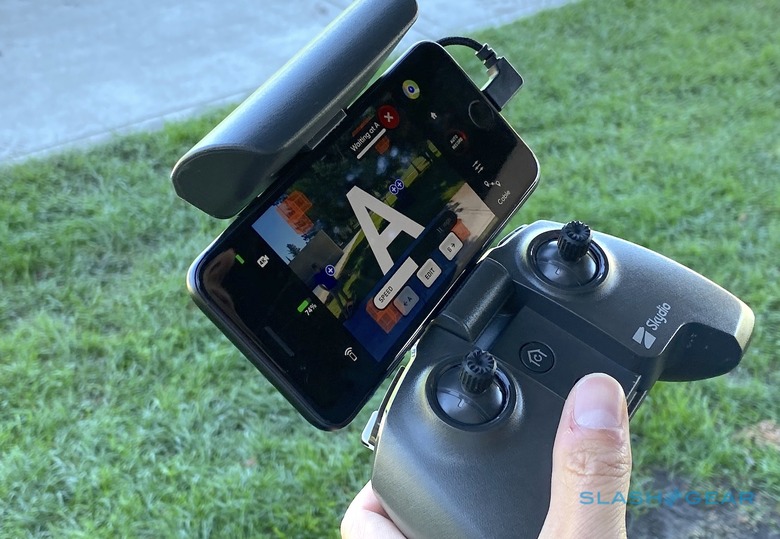
Jam the sticks on the Skydio Controller forward and yes, the drone will go whooshing off. It doesn't override the object avoidance, however, and so instead of hurtling into trees, Skydio 2 just neatly whipped between them. Skydio Beacon is even easier: point it at the hovering drone, hold down the button, and then "drag" it to where you want it. Other keys control how far it is away from you, and then as you move around it'll automatically follow, keeping you in the center of the frame.
What I like most about Beacon is the immediacy. Even as I tried to control an electric scooter, I was able to use the remote's buttons to bring Skydio 2 in closer or send it away, or reposition where it was in relation to me. If you want the drone to follow you, either directly or from an angle, it can do that; or, you can move it around so it's ahead of you, or following from the side. Through the Skydio app you can select a "dronie" camera shot – zooming up into the sky, for example, and then surging back down to you for a more dramatic clip – and preconfigure that to a shortcut button on the Beacon.
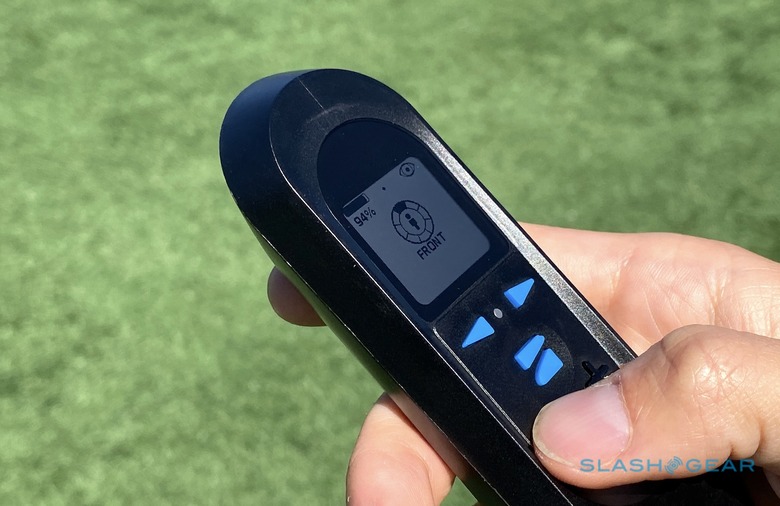
You still get all the old dronies and features, like being able to set a "cable" path to which the drone's movements are constrained but along which it can track as it follows you, and the ability to lock onto vehicles. I'm particularly keen to try out the latter in the wild, where Skydio 2's higher top speed and Beacon's boosted range should make it a lot more useful in car tracking shots. The extra processing power should make adding new features more straightforward for the company, too, and Skydio is also working with third-parties on industry-specific skills like using the drone in surveys.
Simpler manufacturing, still in the USA
Skydio's headquarters are in Redwood City, CA. Walk out the front door, and cross the road, and you're at its manufacturing facility. Sales ambitions for Skydio 2 are obviously higher than for R1 – though the company won't say how many of the first-generation drone it sold – but it's still going to make them in the US.
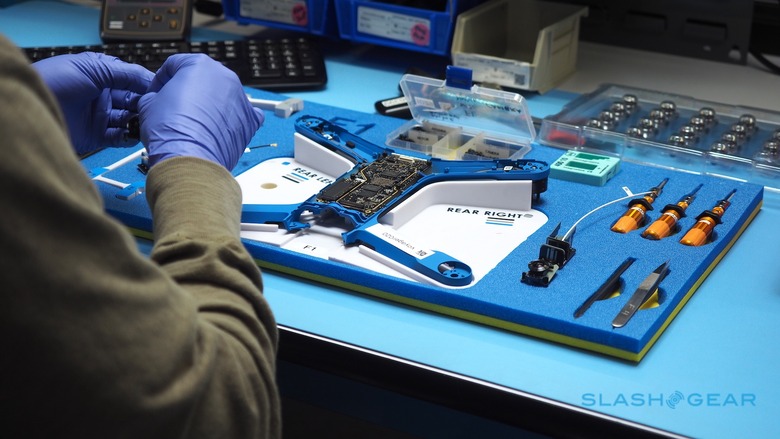
Streamlining that manufacturing process has been essential to making Skydio 2 so much smaller, and so much more affordable. Components that were once spread across a handful of different boards are now centralized onto a single PCB. A series of installation jigs make fitting things like motors in the right orientation, first time, more straightforward.
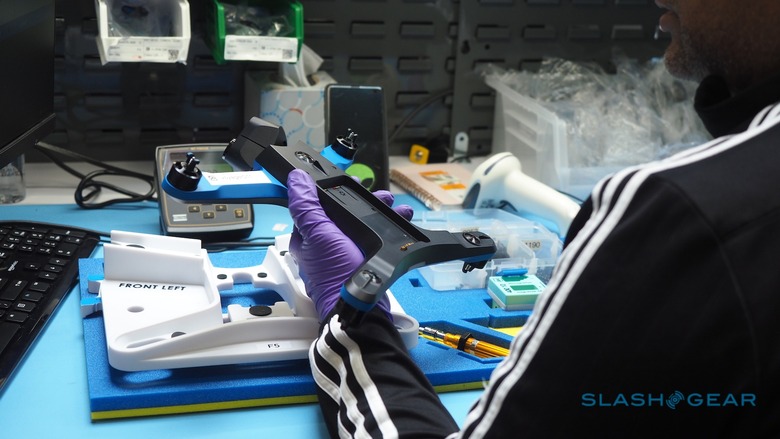
At the end of the line, there's an automated optical configuration – the drone on the end of a robotic arm, tilted around as it reads numerous QR calibration codes – and a burn-in test, both on the ground and in the air. It means any errors can quickly be addressed before Skydio 2 leaves the building. Even so, despite the streamlining and the improved design, the company tells me it expects demand to outstrip supply.
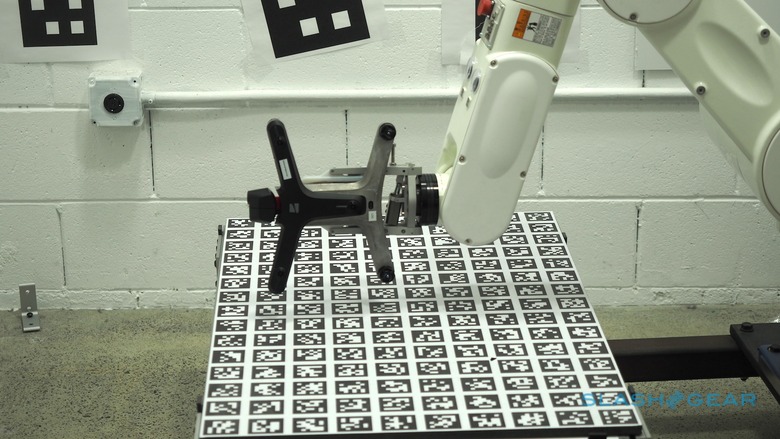
The future of drones is both simple and complex
Watching Skydio's videos of what the new drone's cameras see, how they classify it in real-time, how the motors respond to it, and the silky-smooth end result, it's easy to get overwhelmed by just how much there is going on. The reality, though, is that Skydio 2 is one of the lowest-stress drones I've ever used. Liberated from the fear of crashing it – either into an object or a person – it becomes as flexible as a regular camera, just one that happens to fly.
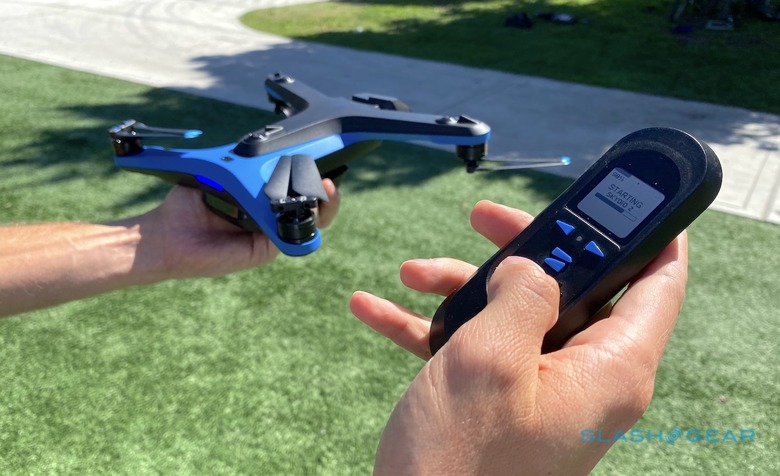
That was the tantalizing promise of the original Skydio R1, hamstrung by its price and its bulk. Skydio 2 brings its autopilot abilities for just $999. Even if you add both the accessories, you're still spending less than for, say, a DJI Mavic 2. I know which one I would rather have following me.
Skydio 2 will ship from November, with $100 reservations being taken from today; orders from the "limited supply" initial batch will ship in time for the holidays. Skydio R1 owners will be offered a "significantly discounted price" for Skydio 2, with the company contacting them directly.
